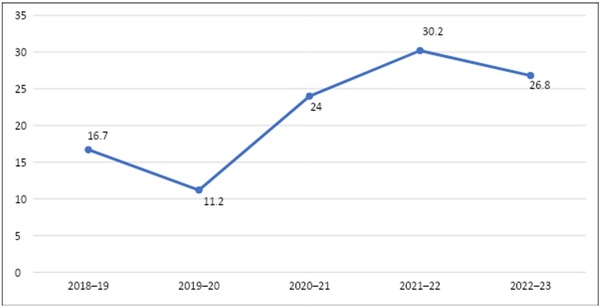Earlier this summer, the Akron Public Schools (APS) board voted to become part of the statewide lawsuit seeking to dismantle Ohio’s EdChoice Scholarship program. Coverage of their decision by the Akron Beacon Journal provides a variety of reasons for spending taxpayer dollars to join a fight aimed at limiting educational opportunities for students and families.
Many of these reasons are questionable. Board member Barbara Sykes, for example, notes that EdChoice “was supposed to be for disadvantaged students and schools that were not meeting the state standards in educating children…now it has just grown to everyone, regardless of what’s happening in their system.”
Perhaps that argument would make sense coming from a school board member of a high-performing district. But for anyone familiar with “what’s happening” in the Akron system, Ms. Sykes’s reasoning should be hard to swallow. For those who aren’t, consider the district’s 2022–23 state report card, which shows that 65 percent of the district’s students failed to meet proficiency standards on state exams. APS moved only 19 percent of K–3 students who were not on track in reading during the prior school year to on-track. And despite praise for the district’s college and career academies, roughly 73 percent of the 1,612 credentials earned by the class of 2022 aren’t in demand by employers or are unlikely to lead to a stable, well-paying job.
Given that APS is doing this poor of a job educating students, the last thing board members should be concerned about is voucher litigation. In fact, the recent voucher expansion will have very little impact on the district, as the majority of APS students would have been eligible for vouchers anyway; forty-four of the district’s forty-seven schools were poor-performing enough to be included on the state’s EdChoice designated list for the upcoming school year. That’s 93 percent of the district’s schools.
Why are board members so intent on limiting options for families when the district’s own schools are so severely lacking? The Beacon Journal coverage offers several reasons. Many are financial, as the board will be asking citizens to vote for a levy this fall despite spending an eye-popping $21,475 of taxpayer funds per pupil during FY23. This new funding request comes in the wake of not only the dismal (and persistent) academic results outlined above, but also a district-commissioned performance audit that contains horrifying statements like “expectations for students are low” and “it is an understatement to say the culture is not one of accountability.” In APS, the audit continues, “consequences are nonexistent” and “poor performance is tolerated.”
However, the most eyebrow-raising reason for actively trying to prevent families from doing what’s best for their kids is the claim that it’s all for the sake of the greater good. According to board president Diana Autry, dismantling EdChoice aligns with the district’s goal of “getting people to understand the importance of public education” because it’s “a public good for all of us that is at risk.”
Autry isn’t wrong when she says that public education is important. But she is wrong when she implies that choosing an alternative to a district school means people don’t value or understand the importance of public education. I can’t speak for all Akron families in this regard. But I can certainly speak for my own.
I spent most of my formative years in a creaky old house with forest green carpet that was located just a few blocks from the Summit County Juvenile Court building and a mere two and a half miles from the current location of LeBron James’s I Promise school. A few months after my sixth birthday, during the summer of 1995, my parents moved my sisters and me to a different home in a nearby suburb. Education was their primary motivation for the move. They wanted their children to attend great public schools, and the APS buildings in our neighborhood didn’t fit the bill.
Up until then, my parents had dealt with the city’s lackluster schools by sending my older sister and me to a nearby private school. Doing so was expensive; EdChoice didn’t exist back then, and the only way my parents could afford tuition was by tucking away their annual tax return. It was unsustainable; my younger sister was set to enter kindergarten in the fall of 1996, and there was no way they could afford to send all three of us to private schools. It also wasn’t what they wanted. They wanted us in public schools. My mom, who not only graduated from a public school, but spent decades working in them, was especially bullish about public education.
But valuing public education—actively wanting to enroll in district schools—didn’t mean it was the right choice. The schools available to us were chronically underperforming and weren’t expected to improve any time soon. They weren’t safe, either, at least not in my neighborhood. Like millions of other families, if my parents wanted us to have access to high-performing and safe public schools, they had no choice but to move to a new district. But also like millions of others, we couldn’t afford to move, given our family income. The only reason our 1995 move was possible was because of an unexpected insurance settlement that gave my parents the funds to relocate to a suburb specifically chosen for its excellent public schools.
It’s been nearly thirty years since my family moved out of the city. A lot has changed since then. Archie the Snowman has moved (but isn’t gone, thank goodness). The empty lot where my sisters and I used to ride our bikes is no longer empty. But the quality of the schools in my old neighborhood—and the rest of the district, too—hasn’t improved. Thousands of families in Akron are just like mine. They want better for their kids but can’t afford to move to find it. They rely on EdChoice scholarships to brighten their kids’ futures.
Meanwhile, board members at APS—those who are partly responsible for the abysmal academic outcomes in my hometown—seem unconcerned with what families want or need. Rather than focusing on improving the schools they oversee so that families actually want to enroll their children, they seek to eliminate other options and force them to attend their “assigned” school, without any regard to whether that school is high quality, safe, or the right fit.
If EdChoice ceases to exist and APS continues to underperform, those who can afford to go elsewhere will. As for everyone else? Well, they’ll just have to settle for low-performing schools. You know, for the greater good.






